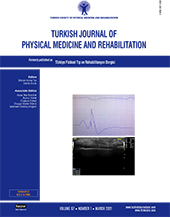Effect of ankle joint fixation on tibialis anterior muscle activity during split-belt treadmill walking in healthy subjects: A pilot study
2 Faculty of Rehabilitation, School of Health Sciences, Fujita Health University, Toyoake, Japan
3 Department of Rehabilitation Medicine I, Fujita Health University, Toyoake, Japan
4 Department of Rehabilitation, Fujita Health University Hospital, Toyoake, Japan DOI : 10.5606/tftrd.2021.4980 Objectives: This study aims to examine the characteristics of muscle activity change of the tibialis anterior (TA) muscle in healthy adults while they walked on a split-belt treadmill with one fixed ankle.
Patients and methods: This randomized controlled trial was conducted between November 2017 and July 2018. Fourteen healthy male individuals (mean age 31.4 years; range, 23 to 50 years) were divided into two groups: right ankle joint fixed by ankle-foot orthosis (fixation group) and no orthosis (control group). Both groups were asked to walk on a treadmill with the same belt speed. After familiarizing with walking on both belts at 5.0 km/h, they walked for 6 min with the right belt slower (2.5 km/h) and the left faster (5.0 km/h). For analysis, the 6 min were divided equally among three time periods. The TA muscle activity was calculated at first and last time periods. We compared muscle activities in time periods (early and late phase) and in groups (fixation and control) using two-way mixed analysis of variance.
Results: The TA muscle activity decreased in the late phase regardless of ankle joint fixation, and also decreased in the fixation group regardless of the time periods. There was an interaction between these factors.
Conclusion: These data show that changes in the TA muscle activity were smaller in the fixation group, suggesting that the ankle joint fixation reduces the adaptation.
Keywords : Ankle joint, gait, orthosis, walking

















